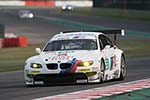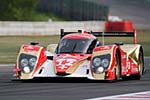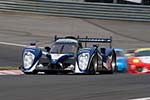
| Click here to save all images | Le Mans Series Spa 1000 km (ILMC) |
| | 2004 | 2005 | 2006 | 2009 | 2010 | 2011 | 2012 | 2013 | |
 Although this year's edition was only the 26th, the Spa 1000 km is an endurance racing classic. During the 1960s and '70s the original circuit was the scene of epic battles first between Ferrari and Ford and later between Ferrari and Porsche. During this period the Belgian track consisted entirely of public roads and was incredibly fast; in 1971 Pedro Rodriguez and Jackie Oliver managed to complete the 1000 km race in just over four hours. With an eye on improving safety the track was heavily modified in the early 1980s. A purpose-built section was added but iconic elements like the daunting 'Eau Rouge' corner were retained. The track is today still among the fastest in the world. In its new guise the Spa-Francorchamps track hosted endurance races throughout the Group C era. After a ten-year hiatus, the rise of the LMP prototype signalled the return of a sports car race at Spa and since 2004 the event has been part of the Le Mans Series (LMS). From 2008 onwards, the race has been scheduled in May, making it the final event, and effectively a dress-rehearsal, ahead of the all-important 24 Hours of Le Mans.
Although this year's edition was only the 26th, the Spa 1000 km is an endurance racing classic. During the 1960s and '70s the original circuit was the scene of epic battles first between Ferrari and Ford and later between Ferrari and Porsche. During this period the Belgian track consisted entirely of public roads and was incredibly fast; in 1971 Pedro Rodriguez and Jackie Oliver managed to complete the 1000 km race in just over four hours. With an eye on improving safety the track was heavily modified in the early 1980s. A purpose-built section was added but iconic elements like the daunting 'Eau Rouge' corner were retained. The track is today still among the fastest in the world. In its new guise the Spa-Francorchamps track hosted endurance races throughout the Group C era. After a ten-year hiatus, the rise of the LMP prototype signalled the return of a sports car race at Spa and since 2004 the event has been part of the Le Mans Series (LMS). From 2008 onwards, the race has been scheduled in May, making it the final event, and effectively a dress-rehearsal, ahead of the all-important 24 Hours of Le Mans.There were subtle changes to the fabric of this year's edition; it is part of the Intercontinental Le Mans Cup (ILMC) for the first time and although the 1000 km moniker was retained, the race would be run over a full six hours. What did not change was the expected battle between Audi and Peugeot for the outright victory. The German and French teams' rivalry will no doubt enter the history books as one of the all-time greats. Despite some late withdrawal's the 2011 Spa 1000 km race attracted a close-to-capacity entry of 55 prototype and GT racing cars, spread over five classes. The event was held under unusually sunny and dry conditions throughout, making the life of the drivers and our photographers a little easier. Their joint-efforts can be found in this 190-shot gallery.
Practice
 One of the main names missing from the entry is Aston Martin Racing. The British team opted to sit out the race and focus on sorting the reliability issues of their AMR-One's straight six engine. The teams that did make it to the Belgian track were a mix of LMS and ILMC regulars with several additional entries like a third Audi and Peugeot.
One of the main names missing from the entry is Aston Martin Racing. The British team opted to sit out the race and focus on sorting the reliability issues of their AMR-One's straight six engine. The teams that did make it to the Belgian track were a mix of LMS and ILMC regulars with several additional entries like a third Audi and Peugeot. Drastic changes to the rules meant that many of the cars had never raced at Spa before, so getting some decent running in the three one-hour practice sessions would be vital. Unfortunately all three sessions featured at least one red flag because of incidents. During the first session one of the Audis was stranded in the gravel. In the second, action was stopped twice; first for an accident of one of the Rebellion Lolas at Eau Rouge and a few laps later for a major shunt between one of the Peugeots and the RML HPD. The damage on the Peugeot was repairable on track but RML was forced to withdraw from the race. Fortunately both drivers escaped major injuries. In the final session on Friday morning one of the GTE-Am Ferraris spun out on top of Eau Rouge, clipping the barriers. Between these stoppages, the eclectic mix of cars did manage to set some representative times. We did hear complaints from drivers in all classes about the sheer number of cars on track. By comparison, at the 24 Hours of Le Mans a similar field is spread over a track twice as long.
At the head field a clear pattern seemed to emerge with the Audis setting the pace in all three sessions with the Peugeots in close pursuit. The petrol-powered Lola Zyteks and Pescarolos running in the same class were at least four seconds off the pace. In the LMP2 class the verdict on the recent restrictor break for the HPD twin-turbo V6 engine was still not out. Danny Watts did manage to set the fastest time during the first session in his Strakka HPD ARX-01d but in the other two the naturally aspirated Nissan and Judd engines still seemed to hold the advantage. The new Ferrari 458 Italia topped the GTE Pro charts in each session with the two semi-works AF Corse cars sharing the honours with the British JMW car. The playing field in the amateur GT class was slightly more levelled between the one-year-old Ferraris and Porsches. Still visibly struggling in the GT ranks was the new Lotus Evora GTE.
Qualifying
 As always, qualifying was spread in two fifteen minute sessions for the GT and prototype cars respectively. The production based sports cars were out on track first on Friday afternoon. Brazilian Jaime Melo managed to convert the pace shown in practice into a GTE Pro pole position in his AF Corse Ferrari. Bobby Bell was second in the JMW Ferrari and Giancarlo Fisichella placed his AF Corse car third. The fastest Porsche was last year's LMS championship winning Team Felbermayr-Proton entry, which set the fourth fastest time, just over half a second adrift. The IMSA Performance Matmut Porsche did manage to defend Stuttgart's honour in the GTE Am class, beating two Ferraris and the Gulf liveried Aston Martin V8 Vantage.
As always, qualifying was spread in two fifteen minute sessions for the GT and prototype cars respectively. The production based sports cars were out on track first on Friday afternoon. Brazilian Jaime Melo managed to convert the pace shown in practice into a GTE Pro pole position in his AF Corse Ferrari. Bobby Bell was second in the JMW Ferrari and Giancarlo Fisichella placed his AF Corse car third. The fastest Porsche was last year's LMS championship winning Team Felbermayr-Proton entry, which set the fourth fastest time, just over half a second adrift. The IMSA Performance Matmut Porsche did manage to defend Stuttgart's honour in the GTE Am class, beating two Ferraris and the Gulf liveried Aston Martin V8 Vantage.Audi and Peugeot showed a very different approach to qualifying, with the German team taking to the track immediately to get a lap on the board. Peugeot decided to wait until the second half of the session. By that time the Audis had already set the three fastest times, in numeric order, with Timo Bernhard in the #1 car on top, followed by Andre Lotterer in the #2 and Tom Kristensen in the #3. Peugeot's gamble backfired as Mathieu Lahaye crashed his Oak-Pescarolo heavily, destroying the car and the barrier in the process. It was the most serious accident of the weekend and the young Frenchman was kept in hospital overnight for observation. The damage to the barrier was so severe that the session and the final support race of the day were called off. This meant that the Peugeots had to start from 13th, 18th and 48th. Considering the pace shown by the new Audi R18 TDI in practice, many believed the race was already run.
In LMP2 Watts managed to get just ahead of the three Nissan engined Orecas. The gap of barely over a tenth was tiny compared to the 2.5 second advantage the very quick Englishman had held a year earlier. Pole in the Formula Le Mans (FLM) class was for the Neil Garner entered Courage-Oreca.
The Race
 Fortunately the Saturday morning warm-up session was completed without incident, leaving the 53 surviving cars ready to take the green flag at 02:05 pm. Before the race we caught up with Audi supremo Dr. Wolfgang Ulrich, who was careful with his predictions for the race, describing the Peugeot's as 'sau schnell', which is German slang for 'bloody fast'.
Fortunately the Saturday morning warm-up session was completed without incident, leaving the 53 surviving cars ready to take the green flag at 02:05 pm. Before the race we caught up with Audi supremo Dr. Wolfgang Ulrich, who was careful with his predictions for the race, describing the Peugeot's as 'sau schnell', which is German slang for 'bloody fast'.Like the warm-up the race got under way very cleanly. McNish in the #3 Audi was already up to second at the end of the 'Kemmel' straight but then spun his R18 TDI following the #1 Audi in close proximity. Like the Peugeots, he was now forced to slice through the field quickly to keep the leading pair of Audis in sight. The 'Wee Scot' spent little time catching up, but surprisingly so did the Peugeots. In fact the French machines proved to be the faster of the two and by the end of the first hour, the #7 Peugeot had captured the lead after starting from the 13th.
In LMP2, Johnny Kane had to give three places in the opening laps as the more powerful engined competition out-dragged his HPD. Despite his best efforts, he was chasing six naturally aspirated cars after the first hour with the Nissan Zytek of the Greaves Motorsport team grabbing the class lead. Unfortunately the class winners of the first LMS race at Paul Ricard had to relinquish the lead to the dominant Oreca 03s. The works-backed Signatech entry next grabbed the top position in the class but in the end it was the TDS entered sister car that claimed the Oreca 03's first class victory. The Strakka team's afternoon long battle was rewarded with a third in class. This fine result was briefly at jeopardy literally in the dying seconds as the car ground to a halt after the final corner of the last lap. After a few anxious moments Watts did manage to get the car started again and grab the final podium position.
 An early collision between one of the AF Corse Ferraris with the fastest Felbermayr-Proton Porsche rendered the GTE Pro class a very one-sided affair. It was nevertheless a very close race as the #71 AF Corse and JMW Ferraris were rarely more than 100 metres apart during the first hours of the race. The tight battle came to a premature end when Bell ran wide at Rivage and clipped the barrier. He managed to carry on but eventually had to pit as the nudge with the wall had sprung a leak in the cooling system. The #71 car also lost time, handing the class lead to the Gianmaria Bruni and Giancarlo Fisichella entered sister car. Second in class is for the Hankook-shod Ferrari of Allan Simonsen and Dominik Farnbacher. Finishing just 1.4 seconds behind was Uwe Alzen in the BMW he shared with Andy Priaulx.
An early collision between one of the AF Corse Ferraris with the fastest Felbermayr-Proton Porsche rendered the GTE Pro class a very one-sided affair. It was nevertheless a very close race as the #71 AF Corse and JMW Ferraris were rarely more than 100 metres apart during the first hours of the race. The tight battle came to a premature end when Bell ran wide at Rivage and clipped the barrier. He managed to carry on but eventually had to pit as the nudge with the wall had sprung a leak in the cooling system. The #71 car also lost time, handing the class lead to the Gianmaria Bruni and Giancarlo Fisichella entered sister car. Second in class is for the Hankook-shod Ferrari of Allan Simonsen and Dominik Farnbacher. Finishing just 1.4 seconds behind was Uwe Alzen in the BMW he shared with Andy Priaulx. There was a small consolation for Porsche in the GTE Am category, which was won by the Nicolas Armindo and Raymond Narac piloted IMSA Performance Matmut Porsche. The class victory for the one-make FLM cars went to the Hope Racing entry in the hands of Luca Moro, Zhang Shanqi and Nicolas Marroc.
At the head of the field, Ulrich's words rang truer than probably he even expected as at one point all three Peugeots lead the three Audis. The German cars all faced issues of some kind with Dindo Capello hitting the pit-lane speed limiter down the start-finish straight, both the #1 and #3 cars requiring a rear bodywork change and the #2 grinding to a brief halt at the pit-entry with fuel pick-up issues. Of the top runners the #9 Peugeot, however, suffered the biggest problems. Pedro Lamy first ran wide and briefly got stuck in the gravel bed. A few laps later, now with Simon Pagenaud aboard, the front right suspension collapsed. He did manage to get the car to the pits and the broken upright was replaced in time for the car to finish in eighth. There were no such issues for the #7 and #8 Peugeots and they clinched an unexpected one-two victory; Peugeot's fifth consecutive victory in the Spa 1000 km. The Audis were third, fourth and fifth and Pescarolo followed up on the team's comeback victory at Paul Ricard with a sixth position as the fastest of the petrol runners.
Final Thoughts
 Following the carnage of the first two days, the six-hour race featured remarkably few major accidents and only one safety car session. This was called for after Christophe Bouchut had a very big shunt in Eau Rouge after the rear suspension on his Level 5 Lola collapsed. Many of the cars that did make it to the finish did show the scars of the multiple smaller coming togethers that were a regular sight throughout the weekend.
Following the carnage of the first two days, the six-hour race featured remarkably few major accidents and only one safety car session. This was called for after Christophe Bouchut had a very big shunt in Eau Rouge after the rear suspension on his Level 5 Lola collapsed. Many of the cars that did make it to the finish did show the scars of the multiple smaller coming togethers that were a regular sight throughout the weekend.On the back-foot during the first two days, Peugeot emerged from the Belgian Ardennes as the clear winners and the French manufacturer will now head for Le Mans as the favourite. Last year's race did show that Audi should never be counted out and the suspension failure on the #9 car will also give Peugeot food for thought.
The 2011 edition of the Spa 1000 km has earned its place in the event's rich history with close racing throughout the field. An impressive crowd of 34,500 people came to enjoy the lovely weather and the ten-tenths racing.
Related Articles
|
|
|||||||||||||||||||
|
|
|||||||||||||||||||
Report by Wouter Melissen and images by Wouter Melissen and Pieter Melissen for Ultimatecarpage.com
| All Cars - Contact us - Privacy Statement - Top | © 1998 - 2024 Ultimatecarpage.com |






